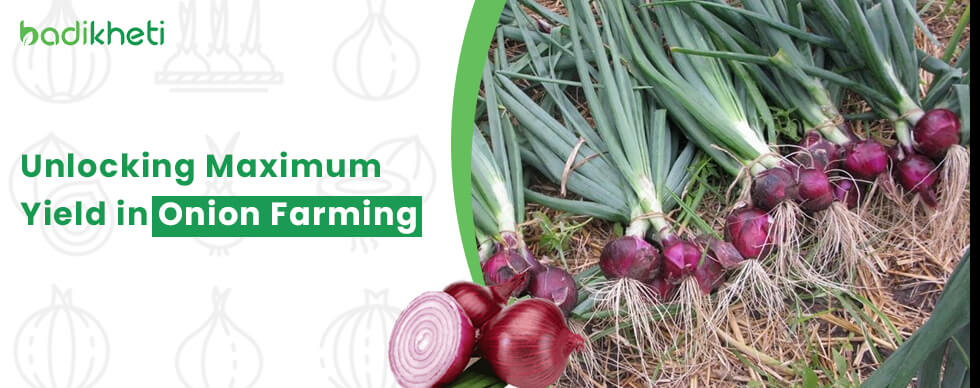
Onions are a popular and versatile vegetable that can be grown in different climates and soil types by following simple steps. Still, one needs to have insights into the best farming practices, the right selection of seeds, the usage of pesticides, and other critical factors that influence the success of onion farming.
Here are some precautions and best practices recommended by experts that you need to take when cultivating onions:
Onions have different day-length requirements, meaning they need a certain amount of daylight hours to form bulbs. Short-day varieties are suitable for southern regions, while long-day varieties are better for northern regions. Intermediate-day varieties can grow in both areas. You also need to consider the quality and type of onion seeds that buy online for any season or time you are planning.
Onions prefer well-drained, fertile, and slightly acidic soil with a pH of 6.0 to 6.8. You need to maintain the soil in order to have good crops and yields. You can amend the soil with organic matter such as compost or manure to improve its texture and nutrient content. Avoid planting onion seeds in heavy clay or sandy soils that can cause root rot or poor bulb development.
Depending on the variety and your region, you can plant onions from seeds, sets, or transplants. Onion seeds are better sown directly in the ground or started indoors 6 to 8 weeks before transplanting, according to agriculturists. Sets are small bulbs that are planted in early spring or late fall. Transplants are young onion plants that are ready to be moved to the farm. Regardless of the method you choose, make sure to plant the onion seedlings about 1 inch deep and 4 to 6 inches apart in rows that are 12 to 18 inches apart.
Onions need consistent moisture throughout their growing season, especially during bulb formation. Water them deeply and evenly once or twice a week, depending on the weather and soil conditions. Avoid overwatering or underwatering them, as this can affect their growth and quality. Agriculturists associated say that onions also benefit from regular feeding with a balanced fertilizer that is high in nitrogen. Apply the fertilizer every 2 to 4 weeks until the bulbs start to swell.
Weeds can compete with onions for water, nutrients, and space, so it is important to keep the area around them clean and weed-free. You can use mulch, such as straw or grass clippings, to suppress weeds and conserve moisture; additionally, you also need to watch out for pests and diseases that can affect onions, such as onion maggots, thrips, leaf miners, root rot, downy mildew, and onion blight. It is also possible to prevent or reduce these problems by rotating crops, removing infected plants, using organic or chemical controls, and practicing good sanitation.
Optimizing onion farming to achieve its maximum yields involves a combination of several factors, such as choosing the right seeds for the region and season, soil preparation, Onion seed planting time and right depth, weed control, using the appropriate amount of pesticides, and adhering to best farming practices.
BadiKheti aims to support farmers at every step of this journey, offering a wide range of agricultural products to buy at affordable rates such as Onion seeds and valuable knowledge to ensure a prosperous and successful harvest. By integrating these insights into your onion farming routine, you can ensure optimal yields and, consequently, improve the profitability and sustainability of your farming venture. After all, successful farming of Onion isn’t just about hard work—it’s also about making smart, informed decisions.
Introduction Chilli fondly known as "Mirchi" in Hindi holds great cultural and historical significance in India. It is not merely a culinary delight but an integral part of our traditions with significant links to agriculture and daily life. India takes great pride in being one of the leading producers and consumers of chillies globally, with various regions contributing to this spicy farming. This article aims to analyze the primary states involved in chilli cultivation within India, exploring their unique functions within the flourishing chilli industry....
The Indian economy is based on agriculture, and the farmer's livelihood relies on the rain in monsoon season. But it isn’t certain, so depending entirely on it may affect soil management and agricultural yields. Crops need a proper quantity of water for their development. The only means our farmers can keep storing and using water properly is via irrigation. In this blog, we will understand the irrigation methods for excellent water management for Indian farmers. Undoubtedly, the world’s agricultural area has increased in the past,...
Onions, also known as Pyaaz, or Kanda are the heart of India and are a lucrative cash crop for farmers here. If you’re looking to maximize onion seed growth and yields, there are certain farming practices that you have to consider. So, proper agricultural practices are critical to maximizing onion output and quality. For the best product, you must have quality onion seeds and proper agriculture equipment in place which you can buy from an online agriculture marketplace like BadiKheti. In this blog, we will...